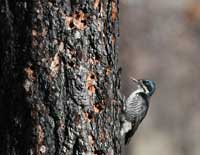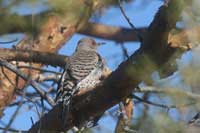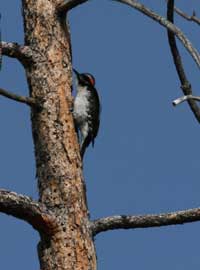From the streets of Moab to the spruce-fir forests cloaking the slopes of the La Sals, there lives a diverse and wild world of woodpeckers.
 One familiar woodpecker of the urban landscape is the brightly-colored Northern flicker. Just because the bird does not bear a “woodpecker” name doesn’t exclude it from this group of hard-headed, chisel-beaked arboreal pounders. Members of the Picidae Family (woodpeckers or picids) are small to medium-sized insectivorous birds that bear stiff tail feathers and specialized skulls and tongues. More on that in a moment.
One familiar woodpecker of the urban landscape is the brightly-colored Northern flicker. Just because the bird does not bear a “woodpecker” name doesn’t exclude it from this group of hard-headed, chisel-beaked arboreal pounders. Members of the Picidae Family (woodpeckers or picids) are small to medium-sized insectivorous birds that bear stiff tail feathers and specialized skulls and tongues. More on that in a moment.
Flickers, given their name for their habit of quickly striking with their bill, are perhaps the best known and least liked member of the picids. At times, flickers attempt to excavate nest cavities in house siding, even pounding through stucco to gain entry to the hollow space between the studs. Never mind insulation packs that space; the flickers soon discard this material to make room for their nest site. Although there are ways to deter flickers from destroying one’s siding, remember that these birds are not malicious, just in search of a spot to lay their eggs.
 Once known as red-shafted flickers, after the coloration of their tail feather shafts, these birds produce a constant and rapid drumming sound to announce their territorial designs. Though the birds tend to use dead trees for this purpose, siding or metal electrical boxes mounted high on light poles are suitable substitutes.
Once known as red-shafted flickers, after the coloration of their tail feather shafts, these birds produce a constant and rapid drumming sound to announce their territorial designs. Though the birds tend to use dead trees for this purpose, siding or metal electrical boxes mounted high on light poles are suitable substitutes.
The drumming pattern, at times, helps to identify the different species in the forest. Both downy and hairy woodpeckers also have a rapid, but shorter and softer drumming sequence. The Williamson’s sapsucker, another member of this picid group, has a drumming sequence that starts out strong, and then fades into a series of random hits, almost like it was forgetting what the bird was up to.
Whereas drumming and calls are used for territorial and breeding purposes, woodpeckers also use their stout bills to either drill holes in tree bark or pry off flakes of bark in search of insects. Some, like the pileated and hairy woodpeckers, hammer holes into trees as they forage for insects. Like the other woodpeckers, these two rely on their long, finely-barbed tongues to snare even deeply embedded insects.
To make room for the length of the tongue, sometimes four times as long as the bill, woodpeckers have special cavities in their skulls into which the tongue retracts. When in use, the sticky-tipped tongue unfurls like a butterfly’s proboscis and laps up either insect or sap.
 Both red-naped and Williamson’s sapsuckers occur in the Moab area, but these creatures do not suck sap as their names lead one to believe. Drilling parallel rows of holes into live trees, these sapsuckers lick up the oozing sap or consume insects trapped in the sticky sap. Both will also consume berries.
Both red-naped and Williamson’s sapsuckers occur in the Moab area, but these creatures do not suck sap as their names lead one to believe. Drilling parallel rows of holes into live trees, these sapsuckers lick up the oozing sap or consume insects trapped in the sticky sap. Both will also consume berries.
This goes to show that woodpeckers may occur in a similar habitat, but specialize in their food preference. Like the flickers. Often viewed perched on the ground, these birds consume ants in large amounts. Then there is the acorn woodpecker, named for its habit of caching acorns into shallow holes drilled into a tree. This caching habit, sometimes done communally, may result in thousands of acorns jammed into one tree.
There is also the Lewis’s woodpecker, named for Meriwether Lewis who first collected this species during his historical expedition to the Pacific Ocean. Brilliantly colored with a pinkish belly and greenish back, these woodpeckers tend to catch insects on the wing, similar to a flycatcher. From a perch, these birds swoop after flying insects or hunt for berries and pine nuts. Like the acorn woodpecker, the Lewis’ will cache food for future use.
In addition to the above species, there are three-toed members of the family: the American three-toed and the black-backed woodpeckers. Both occur in the La Sals and have a habit of prying off large chunks of bark to get at the wood-boring insects below. Lacking a fourth toe, these woodpeckers are appropriately named.
So whether walking the Mill Creek Parkway in town or the Miner’s Basin trail in the La Sals, keep an eye, and an ear, open for the hammer-heads of the forest – the woodpeckers.
